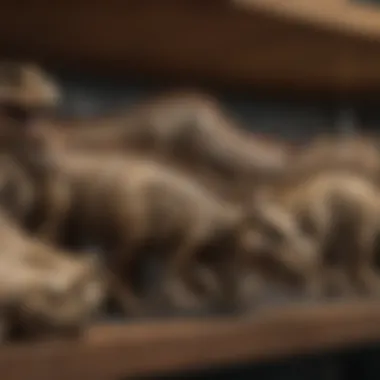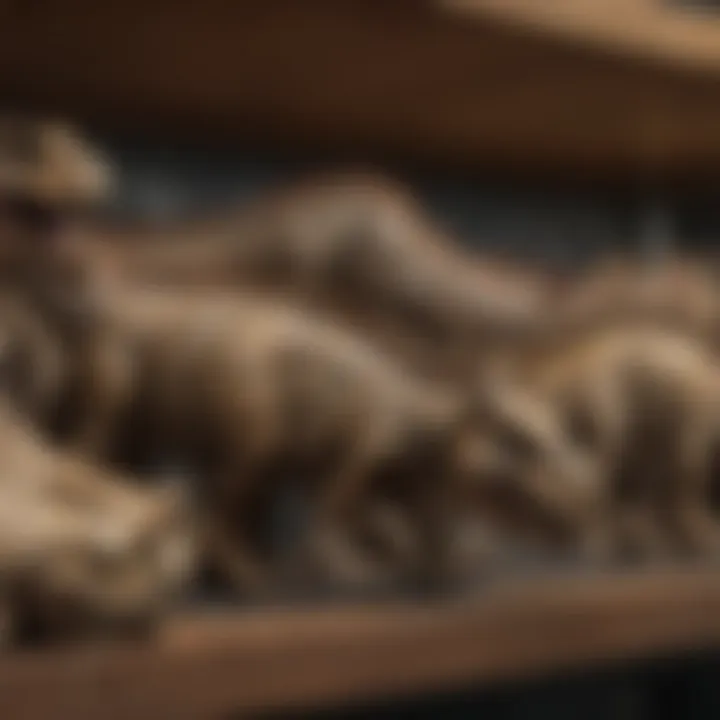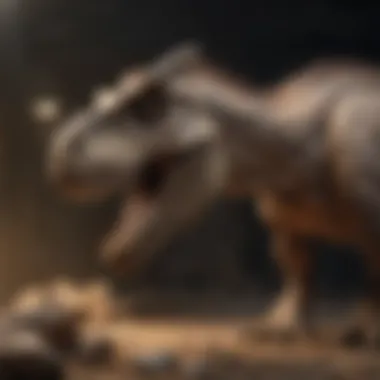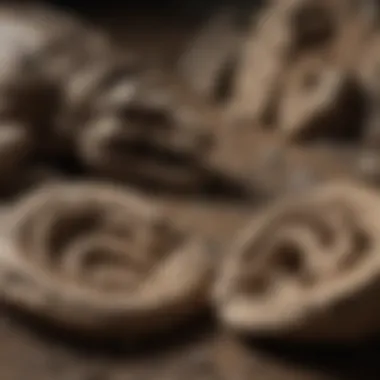Affordable Dinosaur Fossils: A Collector's Guide


Intro
The domain of dinosaur fossils has long fascinated enthusiasts, from casual collectors to professional paleontologists. In recent years, a growing niche has emerged around affordable dinosaur fossils. These fossils, often accessible to individuals who may not possess vast resources, present unique opportunities and challenges. This article will delve into the complexities of collecting cheap dinosaur fossils, exploring various facets such as pricing dynamics, ethical considerations, and educational significance. By providing a comprehensive overview, both novice and seasoned collectors can navigate this particular market with knowledge and confidence.
Featured Collectible of the Month
Overview
This month, we spotlight the Hadrosaurus toe bone. This fossil has captivated collectors due to its affordability and significance. Hadrosaurs, commonly known as duck-billed dinosaurs, roamed the Earth during the Late Cretaceous period. The toe bone, typically ranging from $50 to $150, makes it an appealing option for those starting their fossil collection journey.
Historical Significance
The Hadrosaurus is crucial not only for its unique physiology but also for its contribution to our understanding of dinosaur evolution. First discovered in North America, this genus has provided important insights into the diet and habitat of herbivorous dinosaurs. Collecting affordable fossils from this group can serve as a tangible connection to significant paleontological breakthroughs.
Identification Techniques
Visual Characteristics
When venturing into the realm of affordable dinosaur fossils, imparting an understanding of identification techniques is vital. Key visual characteristics include:
- Coloration: Fossils can exhibit hues from dark browns to vibrant reds, usually providing clues about their composition and origin.
- Texture: The surface might be smooth or rough, depending on the weathering and preservation conditions.
- Shape: Each fossil has distinct patterns and shapes that correspond to specific species, aiding in identification.
Resources for Identification
For those keen on verifying fossils, several resources can prove invaluable:
- Wikipedia: A comprehensive source for genus-specific details and historical context. Wikipedia - Dinosaur Fossils
- Britannica: Offers well-researched articles that give an overview of paleontology and fossil collection. Britannica - Paleontology
- Forums: Engaging with communities on platforms like Reddit can provide practical insights. Reddit - Fossil Collectors
"Understanding the nuances of fossil identification can elevate your collecting experience and enhance educational discussions."
Prelims to Cheap Dinosaur Fossils
The market for dinosaur fossils has long been an area of intrigue. Collectors and enthusiasts seek to understand the range of available fossils and what makes them so valuable. In this article, we will explore this niche market, particularly focusing on the elements that contribute to the affordability of dinosaur fossils. Inexpensive fossils can serve as entry points for new collectors, making the world of paleontology accessible to a wider audience. Also, awareness around pricing gives collectors insight into forming sound purchasing decisions and ensuring they invest wisely.
Defining Cheap Dinosaur Fossils
Cheap dinosaur fossils are typically defined as those that are priced lower than market expectations, often due to factors like their quality, authenticity, or the rarity of the species. Fossils in this category can range from small bone fragments to less detailed specimens, which may not meet the higher standards set by professional collectors. Still, they hold significance for enthusiasts, making paleontology obtainable for many.
A true understanding of what constitutes a cheap fossil requires buyers to look beyond just the price tag. Factors such as the fossil’s origin, its preparation, and any perceived historical value will play crucial roles in assessing its affordability. Furthermore, aspiring collectors are encouraged to educate themselves regarding the different types of fossils available, as this knowledge can significantly enhance their collecting experience.
The Evolution of the Fossil Market
The fossil market has undergone substantial changes over the years. At one time, collecting fossils was primarily the domain of professional paleontologists and affluent collectors. Historically, the prices for authentic, well-preserved fossils were prohibitively high, limiting access to a select few. However, with advances in techniques for finding and preparing fossils, as well as a growing interest in paleontology from the public, the market has diversified.
As the demand for educational resources and personal collections has risen, so has the variety of available fossils. This has led to a proliferation of cheaper options but not without challenges. The increase in supply has also brought about more replicas and lower-quality fossils, making it essential for buyers to discern between genuine specimens and imitations. While this evolution has democratized fossil collecting to some extent, it has also fostered a need for greater awareness of authenticity and ethical collecting practices.
"Understanding the evolution of the fossil market is essential for navigating its complexities today."
Cheap dinosaur fossils represent a dynamic intersection of science, art, and commerce. As the market continues to evolve, collectors will need to engage critically with both the products available to them and the larger ethical implications of their collecting practices.
Factors Influencing Fossil Prices
Understanding the factors that influence the prices of dinosaur fossils is critical for collectors and enthusiasts. The fossil market operates under unique conditions unlike any other marketplace. Buyers and sellers must navigate a plethora of elements that determine value.
Market Demand and Supply Dynamics


The dynamics of market demand and supply play a significant role in pricing dinosaur fossils. When a specific fossil type becomes trendy, demand surges. This higher demand can, in turn, lead to increased prices. For instance, fossils of popular species like Tyrannosaurus rex tend to command higher prices due to collectors’ interest.
Conversely, if supply exceeds demand, prices typically decrease. Factors such as fossil discoveries, geological events, and mass excavations can flood the market with certain types of fossils. It’s essential for buyers to keep track of current trends to make informed purchasing decisions. Researching recent finds can provide insights into potential future prices for certain fossil types, which can save collectors money over time.
Authenticity and Provenance
Authenticity and provenance are critical aspects that significantly impact fossil prices. Buyers prefer fossils that are verified as genuine. Fossils with well-documented histories tend to have much higher values. Lack of documentation can decrease a fossil's worth considerably. A buyer should always ask for evidence of authenticity, such as certificates from paleontologists or recognized institutions.
Furthermore, the legal sourcing of fossils matters a great deal. Fossils sourced illegally or from protected sites can be sold at lower prices, but they may carry significant legal risks. Collectors should investigate prior claims and ensure that the fossils are legally acquired.
Fossil Preparation and Quality
The preparation and quality of the fossil are also essential factors affecting prices. A fossil that has been carefully excavated and preserved often fetches a higher price. Quality factors include how well the fossil has been cleaned, its aesthetic presentation, and how well it has been repaired, if needed.
Technical aspects like the size of the fossil and the integrity of the specimen also play important roles. For instance, a large, intact dinosaur bone is likely to be priced higher than a small or fragmented piece. Enthusiasts should be vigilant and check for any restoration work. Quality assurance can prevent unfortunate purchases of low-grade fossils that do not match the expected value.
"Understanding these factors can lead to better buying decisions and investment opportunities in the fossil market."
In summary, prices of dinosaur fossils fluctuate based on a combination of market dynamics, the authenticity and provenance of the fossils, and their preparation and quality. Each of these aspects not only informs collectors about the current market but also equips them with the knowledge necessary to build a valuable collection.
Types of Cheap Dinosaur Fossils Available
The diversity of dinosaur fossils offers collectors a wide range of options at various price points. Understanding the types of cheap dinosaur fossils available is essential for anyone interested in this niche market. By categorizing fossils, buyers can make informed decisions based on their interests and budgets. Moreover, knowing what is commonly available can help enthusiasts distinguish between genuine finds and less valuable items.
Commonly Found Fossils
Commonly found dinosaur fossils include items like sauropod vertebrae, teeth from theropods, and carnivorous dinosaur claws. These fossils are often plentiful in excavation sites, primarily due to their larger size and the quantity of specimens discovered over the years.
For instance, Hadrosaur teeth are frequently unearthed, making them a popular choice among collectors. Their relative abundance contributes to their affordability. Generally, buyers can expect lower prices for these common types. The market sees sizes ranging from small tooth fragments to larger vertebrae, appealing to a variety of collectors.
One important aspect to note is that while the price may be low, provenance remains critical. Collecting from legitimate sources ensures that the fossil's origin can be traced, thereby maintaining its legitimacy and scientific value.
Uncommon Fossils at Low Prices
When exploring uncommon fossils, collectors may come across exceptional finds that are still priced reasonably. Fossils such as smaller dinosaur bones and fossilized eggs can sometimes be found at lower price points due to their less marketable nature.
Fossilized small raptor claws often go underappreciated yet can be found at surprisingly affordable prices. Being both unusual and lesser-known, these items tend to attract niche collectors who value uniqueness over wholesale availability.
While these fossils may not carry the same weight as legendary finds like a Tyrannosaurus rex skull, they provide unique value. Collectors inclined towards specific interests may enable them to acquire remarkable specimens without breaking the bank.
Replicas vs Real Fossils
The choice between replicas and real fossils is crucial. Replicas offer an ethical and economical solution for those wanting to experience the beauty of dinosaur artifacts without the high cost. For example, scientifically made replicas of dinosaur skulls can provide visual appeal and educational value while being accessible to a wider audience.
On the other hand, real fossils hold their own allure. They represent a tangible link to the past and can serve as valuable educational tools. However, the price spectrum is wider, and quality can vary significantly. Some collectors may prefer the authenticity and unique history that comes with a genuine find, even if it requires a larger investment.
The decision ultimately depends on what collectors value more: educational objectives and aesthetic appeal of replicas, or the authenticity and historical significance of real fossils.
"Fossils are more than just objects; they are fragments of history that connect us to our planet's distant past."
In summary, understanding the various types of cheap dinosaur fossils helps potential buyers navigate the market effectively. Awareness of common versus uncommon finds, as well as the distinctions between replicas and real fossils, can lead to smarter purchases and richer collecting experiences.
Ethical Considerations in Fossil Collecting
In the realm of dinosaur fossils, ethical considerations play a crucial role in guiding collectors, educators, and hobbyists alike. Understanding these principles is essential for fostering a responsible approach to fossil collecting that honors the scientific and cultural significance of these ancient remains.


Legal Aspects of Fossil Acquisition
The legal landscape surrounding fossil acquisition is complex and varies greatly from one region to another. Many countries have specific laws governing the collection, sale, and export of fossils. These laws are designed to prevent illegal excavation and to protect important paleontological sites. For example, fossils found on public land often belong to the state and require permits for legal collection. Ignoring these regulations can lead to hefty fines and the loss of valuable specimens.
Beyond local laws, international agreements, such as the Convention on International Trade in Endangered Species (CITES), also apply. Certain fossils, particularly those from endangered species or critical habitats, may be heavily regulated. Collectors must educate themselves about the legal requirements of their specific locations and ensure compliance to avoid ethical dilemmas.
Preservation of Paleontological Heritage
Preserving paleontological heritage is fundamental to ensuring future generations can study and enjoy these fossils. Ethical collecting practices contribute to this goal by promoting sustainable methods and minimizing damage to natural sites. Every fossil tells a story that contributes to our understanding of Earth's history. When collectors disturb sites without regard for their context, they can lose crucial information about the ecosystem, geology, and evolutionary history involved.
Many organizations focus on the conservation of important fossil sites, often rallying support from the community and educational institutions. It is vital for collectors to participate in these efforts, either by donating fossils to museums or supporting conservation initiatives. This collaborative approach not only aids in preserving the past but also enriches the collective knowledge of the scientific community.
"Ethical fossil collecting is not just about acquiring specimens; it is about respecting the cultural and scientific value they hold."
Adopting ethical practices in fossil collecting not only protects our heritage but also enhances the reputation of the entire hobbyist community. By being conscientious, collectors create a positive impact that may encourage others to appreciate and engage with paleontology responsibly.
Quality Assessment for Buyers
Assessing the quality of dinosaur fossils is crucial for both new buyers and experienced collectors. The market for affordable dinosaur fossils can be overwhelming, particularly for those unfamiliar with the various factors that influence fossil quality. When approaching the purchase of a fossil, understanding its details can prevent potential pitfalls and ensure a worthwhile investment.
Quality assessment involves evaluating various aspects of a fossil, such as its authenticity, preservation state, and overall value. For buyers, this means looking beyond mere aesthetics to grasp the scientific significance and the genuine context of the fossil. This knowledge helps buyers make informed decisions, which is essential in a market where both genuine and misleading offerings coexist. In addition, investing time in quality assessment fosters a sense of responsibility toward the fossil itself and the broader paleontological community.
Recognizing Quality in Fossils
Recognizing quality in dinosaur fossils involves several specific measures. First, pay attention to the fossil's condition. Quality fossils are generally well-preserved, with clear details that represent the species accurately. Common indicators of high quality include intact bones or teeth, minimal repair work, and a natural looking surface. A good fossil should also reflect the age of the specimen, showing relevant geological characteristics without excessive wear.
Consideration of authenticity is also vital. Certification from recognized paleontologists or institutions is often the best way to confirm that a fossil is genuine. Look for provenance, which records the fossil's history and how it was collected. Knowing where the fossil comes from can add to its value.
Potential buyers may also look at comparative examples of similar fossils. If a fossil appears drastically different from those of the same species, it warrants further scrutiny. Utilizing online resources, such as Wikipedia or Britannica, can help provide context for comparison.
Tips for Avoiding Fraudulent Sales
Fraudulent sales can tarnish the joy of fossil collecting. To protect oneself from scams, it is wise to adhere to a series of best practices:
- Research sellers: Investigate any seller's reputation. Platforms like Reddit and Facebook can provide insight through community feedback.
- Request documentation: Always ask for proof of authenticity. Reliable sellers should be willing to provide evidence, such as expert appraisal or a certificate.
- Inspect the fossil in person: If possible, see the fossil before buying. This allows for a closer inspection of quality and condition.
- Trust your instincts: If something feels off about the transaction, such as price too good to be true, consider walking away.
- Engage in forums and communities: Active participation in collector forums can keep you informed about current trends and potential scams.
By following these tips, buyers can mitigate the risks associated with fossil purchasing. This way, the process can become a rewarding experience rather than a regrettable mistake.
The Role of Dinosaur Fossils in Education
Dinosaur fossils serve a significant role in education by acting as both tools for learning and as gateways to deeper knowledge about paleontology, geology, and biodiversity. Through the study of these fossils, students and enthusiasts alike gain insights into Earth's history and the processes that shaped it. Affordable dinosaur fossils, in particular, create opportunities for a broader audience to engage with these ancient remnants of life.
Fossils as Educational Tools
Fossils can illustrate complex scientific concepts in a tangible way. For instance, the study of dinosaur fossils allows learners to understand evolution, extinction, and the environmental conditions of past eras. In classrooms, educators can use inexpensive fossils to demonstrate key topics such as:
- Ecosystem Dynamics: By analyzing different species of dinosaurs and the flora that coexisted with them, students can grasp the concept of ecological balance.
- Geological Time Scale: Fossils help place significant events in a chronological context, making the abstract notion of deep time more relatable.
- Scientific Method: Hands-on activities involving fossils teach students to employ critical thinking, hypothesis testing, and observational skills.
The affordability of these fossils makes them accessible for educational purposes in schools and informal learning environments. Teachers can incorporate these relics into their curricula without breaking the budget, making paleontology a subject of interest among a diverse group of students.
Fossil Exhibits in Museums
Museums are crucial for the preservation and presentation of dinosaur fossils. Exhibits give the public an opportunity to appreciate the size, diversity, and historical context of these creatures. Affordable fossils often find their place in smaller exhibits, community museums, and local science centers, broadening the availability of educational resources.
- Interactive Learning: Many modern exhibits include interactive elements that engage visitors. Hands-on displays allow attendees to touch replicas or view fossils under magnification, deepening their understanding.
- Workshops and Programs: Museums often organize educational programs around their fossil collections, inviting experts to discuss paleontological topics or hosting dig days where participants can search for their own fossils.
- Connecting to the Community: Local fossils can bring the science of paleontology to home turf. Some museums feature fossils that collectors in the region have donated, making the subject relatable to the local audience.


In summary, the role of dinosaur fossils in education cannot be overstated. These ancient remnants provide a conduit for knowledge, engagement, and community interaction. By unlocking the past, affordable dinosaur fossils are crucial not just for collectors but also for shaping informed future generations.
"Fossils transform the abstract into the tangible, making science accessible to all."
Exploring the significance of these fossils in educational contexts ultimately underscores their value beyond mere collection; they are critical in fostering scientific curiosity and engagement.
Conservation Efforts and Funding
Conservation of dinosaur fossils involves more than just protecting ancient specimens; it plays a crucial role in preserving Earth’s history and promoting scientific research. The importance of conservation cannot be overstated. As the fossil record holds insights about prehistoric life, our understanding of evolution and climate change can significantly benefit from these findings. Low-cost fossils often appear in the market, raising concerns regarding their source and the potential for irresponsible collecting practices.
Funding for conservation efforts is equally significant. Without adequate financial support, both organizations and researchers may struggle to implement effective conservation practices. This creates a potential disconnect between the availability of fossils and the responsibility of preserving them for future generations.
Organizations Supporting Fossil Conservation
Numerous organizations focus on the conservation of fossils and paleontological research. Some notable groups include:
- The Paleontological Society: This organization promotes the study and preservation of fossil resources. It engages in various initiatives to improve public awareness and collaboration among different stakeholders in paleontology.
- Society of Vertebrate Paleontology: This group not only supports fossil conservation but also facilitates research and education in vertebrate paleontology. They provide resources and grants that assist researchers in their efforts to study and protect fossil sites.
- The National Park Service: The service oversees many sites rich in fossils. They protect these locations from over-collecting and ensure that fossils remain part of the global heritage.
- World Wildlife Fund: Although primarily focused on living ecosystems, this organization also engages in projects highlighting the importance of ecosystems in the past, including fossils as part of that narrative.
These organizations advocate for legal protection of fossil sites and contribute to raising funds that aid in preservation projects. Their efforts often require collaboration with governmental bodies and private sectors to achieve lasting positive impacts.
Funding Initiatives for Paleontological Research
Financial initiatives for paleontological research come from various sources, each contributing a distinct layer of support. For example:
- Grants from Government Agencies: Entities like the National Science Foundation and the National Geographic Society often provide grants specifically for fossil research and conservation efforts. These grants allow researchers to conduct important fieldwork and simulations to analyze fossil data.
- Crowdfunding Platforms: Many individuals and small research teams now use platforms like Kickstarter or GoFundMe to raise money for specific projects. These initiatives can directly involve the public in fossil conservation through donations, enabling a community feeling around the cause.
- Educational Institutions: Universities and colleges frequently foster research on fossils as part of their curriculum. They allocate funding for graduate research projects that ultimately contribute to the broader paleontological knowledge.
- Private Donations: Many wealthy philanthropists with interests in science and education contribute to paleontological research. Their support can directly influence the success of archaeological digs and preservation projects.
Overall, the combination of these funding sources ensures that various conservation efforts can sustain and expand the paleontological field.
"The dedication to fossil conservation reflects our commitment to understanding the past and educating future generations."
Supporting fossil conservation through funding is vital for the continuation of research and the preservation of Earth’s prehistoric treasures. For rock and fossil collectors, understanding the efforts and funding initiatives in place is crucial for responsible and ethical collecting. As they engage with the fossil community, they can also contribute to these causes, ensuring that fossils remain accessible for future study and enjoyment.
Connecting with the Fossil Community
Connecting with the fossil community is crucial for anyone interested in affordable dinosaur fossils. This connection can enhance the experience of collecting and provide invaluable resources. By joining forums and clubs, enthusiasts can share knowledge, trading opportunities, and even advice on best practices regarding fossil acquisition. The significance of community also extends to fostering a deeper appreciation for paleontology as a science and a hobby. Shared experiences can help new collectors avoid pitfalls and navigate the complexities of the fossil market.
Forums and Online Platforms
Online forums are an excellent starting point for anyone wanting to dive into the world of dinosaur fossils. Websites such as Reddit have dedicated channels where collectors and enthusiasts converse about their findings, techniques, and the market itself. Joining these discussions allows individuals to learn from experienced collectors. Knowledge around identification, pricing, and preservation of fossils flows freely in these digital spaces. It can also help collectors stay informed about ethical practices and recent discoveries in the paleo community.
In addition to Reddit, sites like Facebook host various groups focused on fossil collecting. Here, members share photos of their finds, ask for feedback, and even organize local meet-ups. Forums and online platforms serve as informal classrooms, making them essential for anyone serious about fossil collecting.
Local Collecting Clubs
Local collecting clubs are another valuable avenue for connecting with fellow fossil enthusiasts. These clubs often host regular meetings, field trips, and workshops. Participating in such groups can provide hands-on experience in fossil hunting while offering direct access to seasoned fossil hunters. Many local clubs have connections to paleontological sites, which can enhance opportunities for collecting.
Moreover, these clubs also focus on education about responsible collecting and preservation methods. Members often share tips on where to find affordable fossils and how to assess their quality. Being part of a local community can help foster relationships with mentors and peers who are passionate about paleontology.
Overall, engaging with the fossil community—both online and locally—opens doors to resources that can enrich any collector’s experience and expertise.
Finale
In concluding this exploration of affordable dinosaur fossils, we emphasize the significance of understanding this niche market within paleontology. Affordable fossils provide opportunities for collectors and enthusiasts to engage with the past without incurring exorbitant expenses. As the interest in paleontological collectibles grows, it is vital to recognize trends and potential challenges within this market.
The Future of Affordable Fossils
The future of affordable dinosaur fossils appears to be a dynamic landscape driven by various factors. Technological advancements in fossil acquisition and preparation have the potential to lower costs significantly. Online platforms and electronic marketplaces increase accessibility for both buyers and sellers, making it easier to find reasonably priced specimens. Moreover, as educational institutions continue to integrate fossils into their curriculums, the demand for affordable fossils may surge. This trend creates a unique intersection between education and collecting, thereby helping to foster a deeper appreciation for paleontology among future generations. Predicted developments in global sourcing of fossils can also lead to a more diverse and affordable range of options.
Final Thoughts for Collectors and Enthusiasts
For those in the realm of fossil collecting, the journey does not merely involve acquiring specimens. It also encompasses a commitment to ethical practices and deeper understanding of paleontological significance. By considering authenticity, provenance, and ethical implications in purchasing decisions, collectors can ensure that they contribute to the sustainable and responsible growth of the fossil market. Sharing knowledge, attending local collecting clubs, and engaging in online forums can also enhance the collecting experience.
In essence, affordable dinosaur fossils serve as a gateway into the wonders of prehistoric life. With thoughtful navigation of the market and a focus on ethical considerations, collectors and enthusiasts can enrich not only their personal collections but also the broader community's appreciation for the Earth's ancient history. > Affordable fossils are not just items of interest; they are pieces of history that offer insights into our planet's past.



